Nearly every weekend, I go for a bike ride or a hike at Black Run Preserve, one of my favorite places. 1300 acres of land owned by the town of Evesham and cared for by a volunteer organization of which I am a member. Like many “preserved” spaces in New Jersey, it has a sewer line running through it on an easement; other places have gas pipelines, power lines, and so on. Once you find these things, your enjoyment may be somewhat lessened, and your gratitude increased. Because it all could have been lost.
Many of the remaining parcels of unpaved land near cities are fenced and off-limits. The land surrounding water reservoirs is often protected this way out of fear of contamination or attack. But we can lose land in other ways. (Just ask the people we stole it from!) Black Run is surrounded by HOAs and million dollar homes and private lakes. Green places are easily lost to developments or made into sanctuaries for the affluent.
I began to notice this when I dropped off a donation of paper towels to Woodford Cedar Run Wildlife Refuge, a rescue and rehab facility. I visited them for a night hike that was cut short by a thunderstorm, but I did get to see their rescued screech owl who can’t be released due to imprinting:
The road from Black Run to the refuge took me past some very expensive houses, and began to notice the signs on the main road, as I headed back to the trailhead: Private Lake. No Trespassing. Private Road, but with a publicly maintained stop light. It made me wonder who would buy a lake and then advertise it on the road, and tell people they can’t go there, except an asshole?
Later that week, I got to find out. I took a ten mile ride around the preserve, following trails I had not taken. One led me to the far end, following a single track that paralleled something called Kings Grant trail. This led me to a bridge over a stream, that was blocked by a newly fallen tree. I happened to have a camp knife in my pack, and felt like some exercise in the oddly cool weather, so I hacked at the log until I could drag it off the bridge:
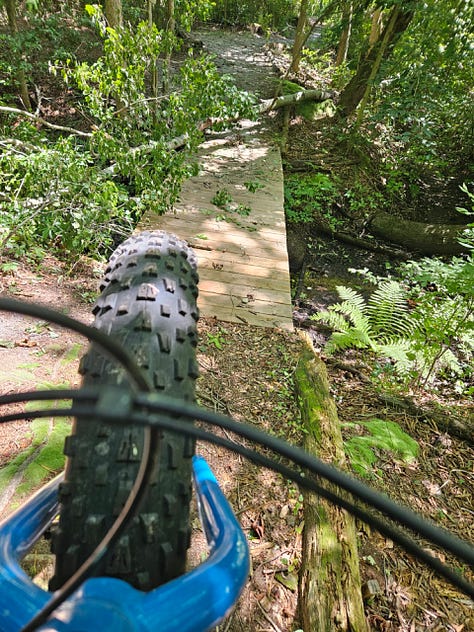
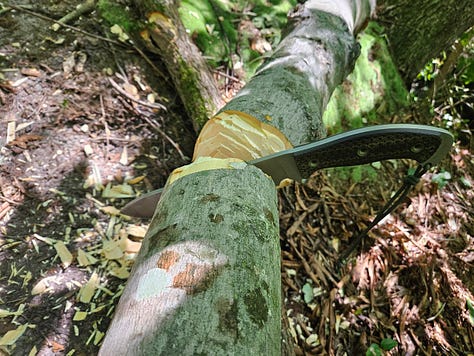
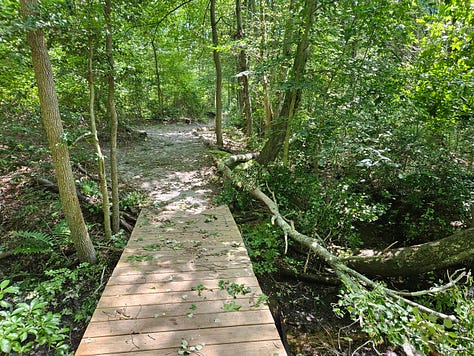
(If you view this in the Substack app, it will break the image gallery into three big photos. View it on the web or in email and you won’t have that problem. The bug has been reported to the Substack team).
I crossed the bridge and it took me to a gravel and dirt path a rusty silo towers and an antenna tower by a power substation, and then opened up into a cul de sac with a fenced-in pump track for kids to learn bicycling. Suburbia, where everything is fenced off. I turned around and headed back, and posted a photo on the Preserve’s Facebook page to let people know the bridge had been cleared.
That was my second mistake. A few people said thanks, but then someone said “thanks, but…” and then informed me that the trail was not part of Black Run, but was “ours,” part of something called Kings Grant. Which was odd, as I saw no “private property” or “no trespassing” signs like I often see in other parts of the preserve. I looked up Kings Grant; they call themselves an “open space association,” but what open space? It’s a housing development with a golf course. It’s a homeowner’s association. Something invented to keep other people out.
A “kings grant” is land given to colonists to encourage immigration for profit to the crown; before the land can be turned into a money-making venture, the first people living on it need to be driven off or murdered by the king’s soldiers. This HOA, like others in the area that abut the Black Run Preserve, have unintentionally ironic names. One which the Pinelands Preservation Association fought unsuccessfully, to protect the habitat of the endangered eastern timber rattlesnake, is called “The Sanctuary.” It wasn’t for the snake; the entire population was destroyed. The golf course development has big trucks and Jeep owners who like to race down the dirt road to the trailhead and dig furrows to keep people with cars from daring to use the public access. Others ride dirt bikes illegally on the preserve.
No Trespassing signs mark their property boundaries that back up to the preserve. I’m sure they consider it “theirs,” think the rest of us are encroachers. I am a reluctant landowner. I don’t like renting much either, so we bought a house. We try our best not to be obnoxious about it. We’re not in a homeowner’s association. We don’t care if you park in front of our house, or if your dog pisses on our lawn. If someone I don’t recognize walks down my street, I assume they live here, and I haven’t met them yet.
So the urge to own a lake, I don’t get it. Not all countries give you the “freedom” to own a lake. In many countries, there’s a freedom we don’t have in the United States, the “freedom to roam.” Scandinavia and the United Kingdom have different variations, but generally you can hike across private land; in some countries you can camp peacefully for two days, and even fish with rod and line in still waters, for sustenance, and forage. You can’t tramp across farmland or steal crops, but if someone buys a lake, you can hike to it and swim in it if you like. I took advantage of this in Ireland, to visit the ruins of a castle.
The gifts of nature can not be owned. This essay by Robin Wall Kimmerer about the gift economy, comes to mind: “The Serviceberry.” Thanks to
for recommending it; her Substack, , is a worthwhile read on how we’ve lost the Commons. If you want a solid primer on the fallacy of “the tragedy of the commons” was used to turn the commons over to private ownership, I recommend “The Theft of the Commons” by Eula Biss.A podcast that ties into this, which I highly recommend, is The Sum of Us by Heather McGhee. If podcasts aren’t your thing, she also wrote a book. McGhee answers the question, “why can’t we have nice things?” by researching public goods that we’ve lost in the United States, such as public swimming pools, and finds why they disappeared. Hint: racism. But what makes McGhee’s interviews with people different is that she follows people who are changing things for the better. She finds people working together to take back what was lost. For example, in one episode, I learned that not only were there “sundown towns” for Black people, but also for Native Americans, and often air raid sirens were employed to give one hour’s warning. These sirens remain an ear-splitting reminder. But for each painful nugget of history revealed through her mining, we also get the gold of people joining to help each other and move forward. Like in Kansas City, where white and black organizers worked together to raise the minimum wage. And in Nevada, where to fight that air raid siren, outsiders who wanted to help trained for months to join a ten mile run led by Ku Stevens of the Washoe tribe that reenacts part of the three escapes of his great-grandfather from the Stewart Indian School.
We’ve got a long way to go, but it’ll be easier together. If we stop cutting our nose to spite our face. Last week’s essay got a lot of love, and
shared a great essay in the comments. Here’s a quote from it:“If the art of drag has taught me one thing, it’s that I am not unique. I believe that everyone does drag. From choosing the clothes we want to wear to parting our hair a certain way, we tend to our roles in a ritualistic fashion. We groom our personas, keep them neat and tidy. We give a lot of attention to ensuring that our ties are tied on straight and our bra straps aren’t showing. Yet when we come home from work after a long day, who doesn’t love to take it all off, throw their feet up on the coffee table, and untuck the last eight hours of their lives?”
—Everyone you meet is God in Drag, by Robert Julius
If private property signs for homes carved out of public nature preserves bothers you, my story “Good People,” which was chosen by Alafair Burke as a Distinguished Mystery Story of 2021, can be read here:




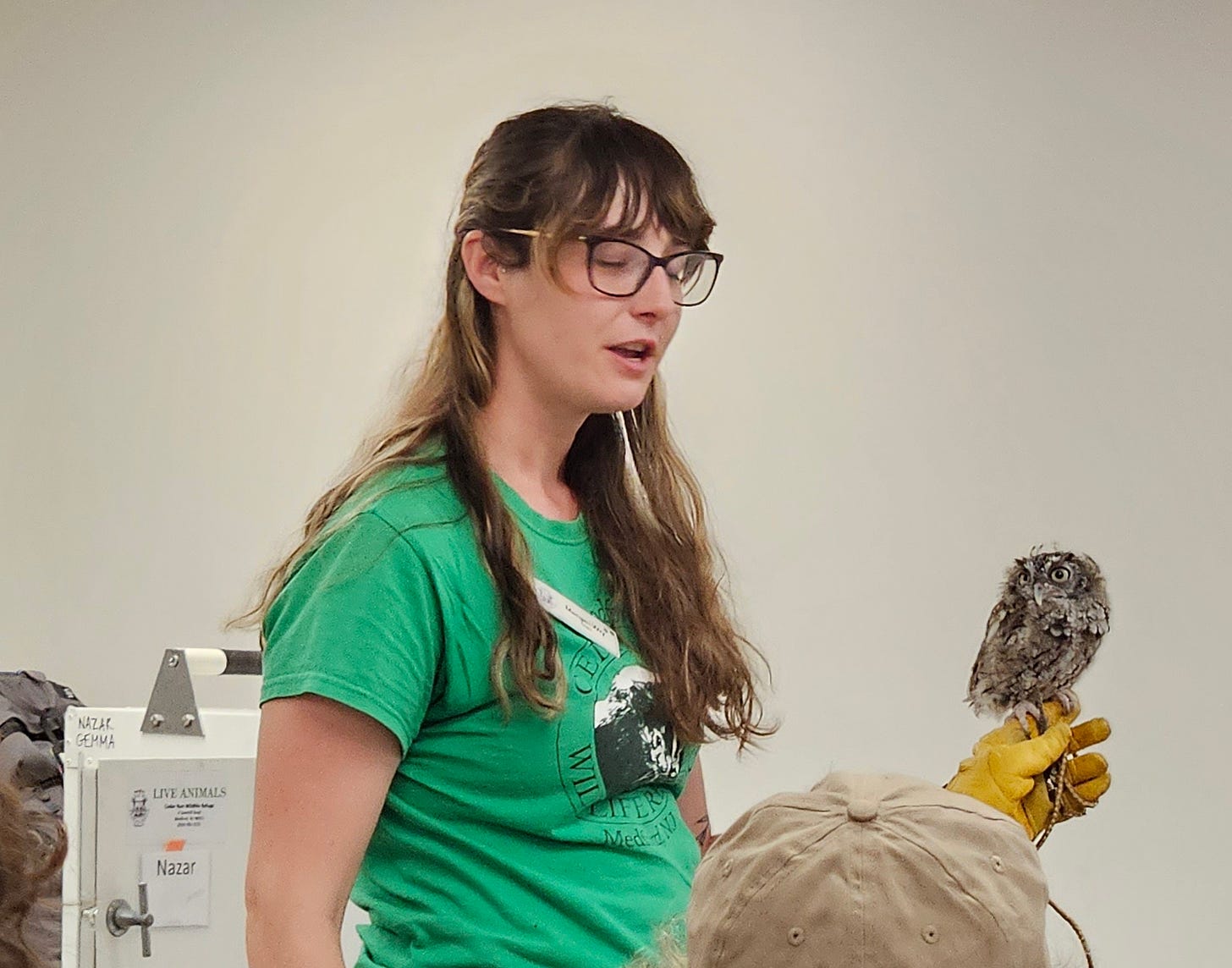
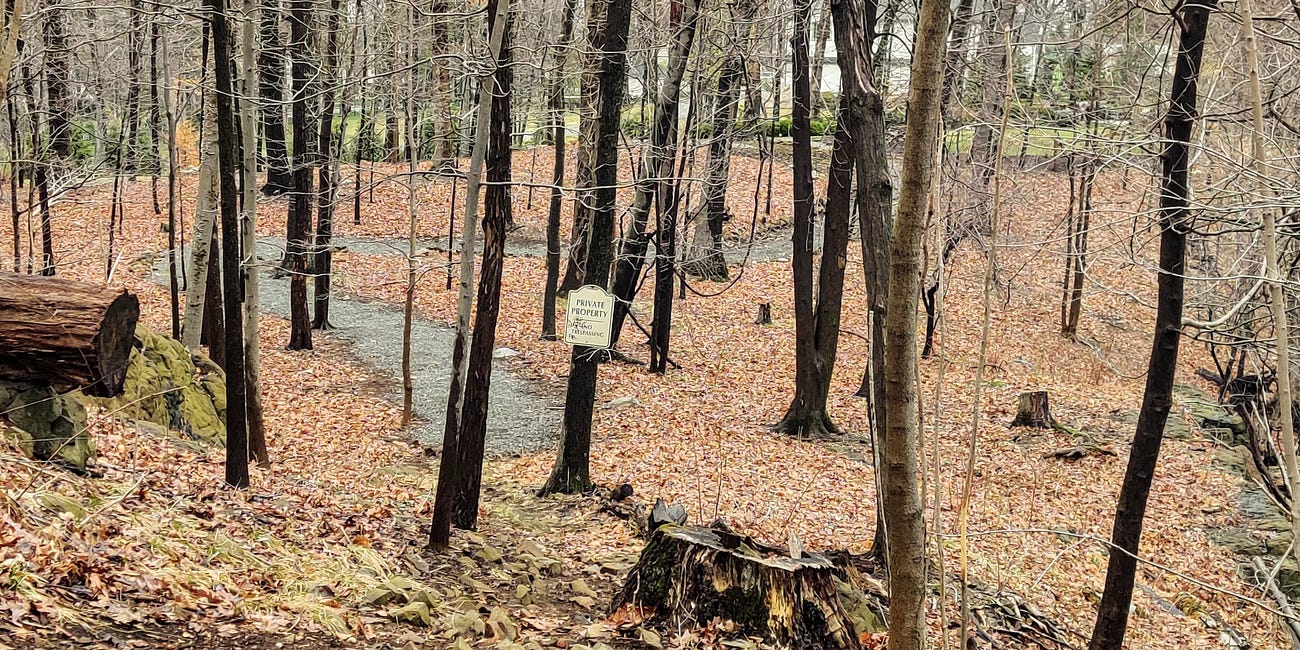
What a great piece. The more I read about the loss of the commons and how that private property regime was forced onto North America, the more pissed off I get about it. Down with “No Trespassing” signs!
And if anyone tries to go all “tragedy of the commons” on you, science writer Michelle Nijhuis published a great answer to why Garrett Hardin was wrong: https://aeon.co/essays/the-tragedy-of-the-commons-is-a-false-and-dangerous-myth
I am a serial and unrepentant trespasser.